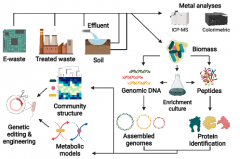Our research is built on the idea that contaminated habitats are a gold mine for biological diversity. We are searching for microbes that hold the key to curbing the negative impacts of environmental pollution.
Mitigating the negative impacts of e-waste
As the demand for consumer electronics has increased in the last decade, so has the environmental footprint associated with their manufacturing and disposal. Managing e-waste is challenging because it represents a contamination source but also contains valuable metals that could be recycled.
The global growth of e-waste has created a new and important environment for microbes that can directly interact with toxic and valuable metals. How e-waste’s unique metal chemistry has shaped microbial metabolisms remains an open question.
We use meta-omics (whole community DNA and proteins) and geochemical analyses to create biogeochemical models for metal cycling in habitats contaminated with e-waste. Our goal is to translate the discovery of novel metal cycling pathways into biotechnology to reclaim metals from e-waste.
The metals we are currently interested in are iron, cobalt, rare earth elements, mercury, and arsenic. These metals are a mix of nutrients essential for life on Earth, priority contaminants, and critical raw materials. The lab is recruiting B.Sc. and M.Sc. students for research projects focused on these metals starting January 2023. Click here to learn about how you can join the lab!

A typical workflow that combines meta-omics and geochemical analyses to characterize microbes in contaminated habitats.
Making consortia safe for use in the environment
A major component of our research involves establishing stable microbial consortia that can be used for waste reclamation. Microbial consortia are complex communities of microorganisms that rely on each other to support metabolic activities that can be useful for environmental remediation.
Although microbial consortia are commercially available for use, there is a gap in how to apply modern analytical techniques to best characterize their composition, metabolic activity, and long-term fate in the environment. These gaps are important to address for risk assessment purposes.
We are working with Environment and Climate Change Canada to develop regulations for the safe use of commercially-available microbial consortia using leading-edge methods in metagenomics and ecotoxicology. We are currently recruiting a M.Sc. student to lead this project starting September 2022 or January 2023. Click here to see the full posting and learn more!